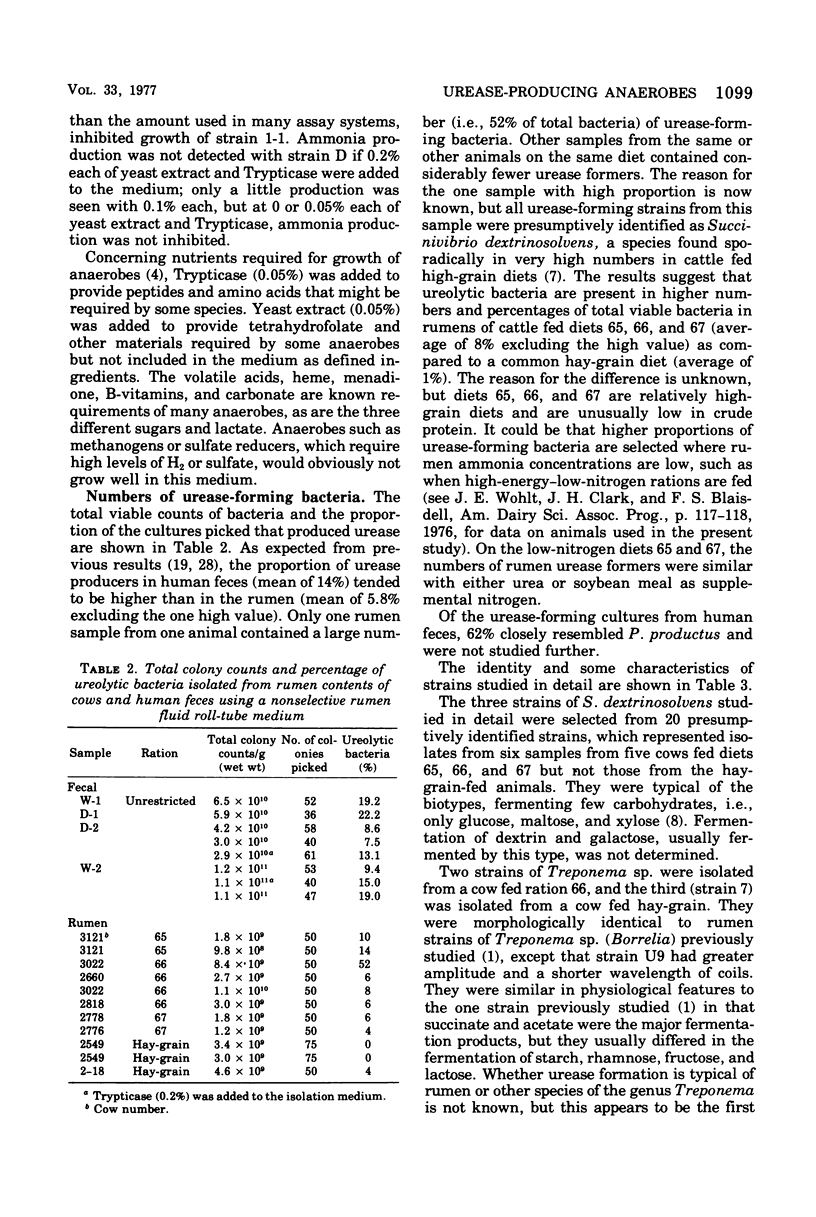Abstract
A growth medium and test were developed for rapid detection of urease in fermentative anaerobic bacteria. Using nonselective rumen fluid roll-tube agar medium and the new test, it was confirmed that Peptostreptococcus productus is often the most numerous urease-forming species in human feces. Also, some fecal strains of Ruminococcus albus, Clostridium innocuum, and Clostridium beijerinckii produced urease. Single strains of Fusobacterium prausnitzii, Coprococcus catus, and Streptococcus mitis that were strongly ureolytic on isolation later lost this ability. Urease activity was also detected in many strains of nonselectively isolated rumen species. They include Succinivibrio dextrinosolvens, Treponema sp., Ruminococcus bromii (not previously known to be present in the rumen), Butyrivibrio sp., Bifidobacterium sp., Bacteroides ruminicola, and P. productus. Most P. productus strains contain urease; however, the uniformity of this feature in the other species noted above is not known. The urease in many of these species was not detected if the growth medium contained 0.2% or more (each) yeast extract and Trypticase.
Full text
PDF







Selected References
These references are in PubMed. This may not be the complete list of references from this article.
- BRYANT M. P., ROBINSON I. M., LINDAHL I. L. A note on the flora and fauna in the rumen of steers fed a feedlot bloat-provoking ration and the effect of penicillin. Appl Microbiol. 1961 Nov;9:511–515. doi: 10.1128/am.9.6.511-515.1961. [DOI] [PMC free article] [PubMed] [Google Scholar]
- BRYANT M. P., SMALL N., BOUMA C., ROBINSON I. M. Characteristics of ruminal anaerobic celluloytic cocci and Cillobacterium cellulosolvens n. sp. J Bacteriol. 1958 Nov;76(5):529–537. doi: 10.1128/jb.76.5.529-537.1958. [DOI] [PMC free article] [PubMed] [Google Scholar]
- BRYANT M. P., SMALL N. Characteristics of two new genera of anaerobic curved rods isolated from the rumen of cattle. J Bacteriol. 1956 Jul;72(1):22–26. doi: 10.1128/jb.72.1.22-26.1956. [DOI] [PMC free article] [PubMed] [Google Scholar]
- BRYANT M. P. The isolation and characteristics of a spirochete from the bovine rumen. J Bacteriol. 1952 Sep;64(3):325–335. doi: 10.1128/jb.64.3.325-335.1952. [DOI] [PMC free article] [PubMed] [Google Scholar]
- Bryant M. P. Commentary on the Hungate technique for culture of anaerobic bacteria. Am J Clin Nutr. 1972 Dec;25(12):1324–1328. doi: 10.1093/ajcn/25.12.1324. [DOI] [PubMed] [Google Scholar]
- Bryant M. P. Nutritional features and ecology of predominant anaerobic bacteria of the intestinal tract. Am J Clin Nutr. 1974 Nov;27(11):1313–1319. doi: 10.1093/ajcn/27.11.1313. [DOI] [PubMed] [Google Scholar]
- Caldwell D. R., Bryant M. P. Medium without rumen fluid for nonselective enumeration and isolation of rumen bacteria. Appl Microbiol. 1966 Sep;14(5):794–801. doi: 10.1128/am.14.5.794-801.1966. [DOI] [PMC free article] [PubMed] [Google Scholar]
- Cook A. R. The elimination of urease activity in Streptococcus faecium as evidence for plasmid-coded urease. J Gen Microbiol. 1976 Jan;92(1):49–58. doi: 10.1099/00221287-92-1-49. [DOI] [PubMed] [Google Scholar]
- Cook A. R. Urease activity in the rumen of sheep and the isolation of ureolytic bacteria. J Gen Microbiol. 1976 Jan;92(1):32–48. doi: 10.1099/00221287-92-1-32. [DOI] [PubMed] [Google Scholar]
- Eller C., Crabill M. R., Bryant M. P. Anaerobic roll tube media for nonselective enumeration and isolation of bacteria in human feces. Appl Microbiol. 1971 Oct;22(4):522–529. doi: 10.1128/am.22.4.522-529.1971. [DOI] [PMC free article] [PubMed] [Google Scholar]
- GIBBONS R. J., DOETSCH R. N. Physiological study of an obligately anaerobic ureolytic bacterium. J Bacteriol. 1959 Apr;77(4):417–428. doi: 10.1128/jb.77.4.417-428.1959. [DOI] [PMC free article] [PubMed] [Google Scholar]
- Holdeman L. V., Good I. J., Moore W. E. Human fecal flora: variation in bacterial composition within individuals and a possible effect of emotional stress. Appl Environ Microbiol. 1976 Mar;31(3):359–375. doi: 10.1128/aem.31.3.359-375.1976. [DOI] [PMC free article] [PubMed] [Google Scholar]
- John A., Isaacson H. R., Bryant M. P. Isolation and characteristics of a ureolytic strain of Selenomonas ruminatium. J Dairy Sci. 1974 Sep;57(9):1003–1014. doi: 10.3168/jds.s0022-0302(74)85001-0. [DOI] [PubMed] [Google Scholar]
- Kadis S., Pugh W. L. Urea utilization by Leptospira. Infect Immun. 1974 Oct;10(4):793–801. doi: 10.1128/iai.10.4.793-801.1974. [DOI] [PMC free article] [PubMed] [Google Scholar]
- Kaltwasser H., Krämer J., Conger W. R. Control of urease formation in certain aerobic bacteria. Arch Mikrobiol. 1972;81(2):178–196. doi: 10.1007/BF00412327. [DOI] [PubMed] [Google Scholar]
- Krämer J., Kaltwasser H., Schlegel H. G. Die Bedutung der Ureaserepression für die taxonomische Klassifizierung von Bakterine. Zentralbl Bakteriol Parasitenkd Infektionskr Hyg. 1967;121(4):414–423. [PubMed] [Google Scholar]
- Moore W. E., Holdeman L. V. Human fecal flora: the normal flora of 20 Japanese-Hawaiians. Appl Microbiol. 1974 May;27(5):961–979. doi: 10.1128/am.27.5.961-979.1974. [DOI] [PMC free article] [PubMed] [Google Scholar]
- Scardovi V., Trovatelli L. D., Crociani F., Sgorbati B. Bifid bacteria in bovine rumen. New species of the genus Bifidobacterium: B. globosum n.sp. and B. ruminale n.sp. Arch Mikrobiol. 1969;68(3):278–294. [PubMed] [Google Scholar]
- Varel V. H., Bryant M. P., Holdeman L. V., Moore W. E. Isolation of ureolytic Peptostreptococcus productus from feces using defined medium; failure of common urease tests. Appl Microbiol. 1974 Oct;28(4):594–599. doi: 10.1128/am.28.4.594-599.1974. [DOI] [PMC free article] [PubMed] [Google Scholar]
- Visek W. J. Effects of urea hydrolysis on cell life-span and metabolism. Fed Proc. 1972 May-Jun;31(3):1178–1193. [PubMed] [Google Scholar]
- WHITE D. C., BRYANT M. P., CALDWELL D. R. Cytochromelinked fermentation in Bacteroides ruminicola. J Bacteriol. 1962 Oct;84:822–828. doi: 10.1128/jb.84.4.822-828.1962. [DOI] [PMC free article] [PubMed] [Google Scholar]


